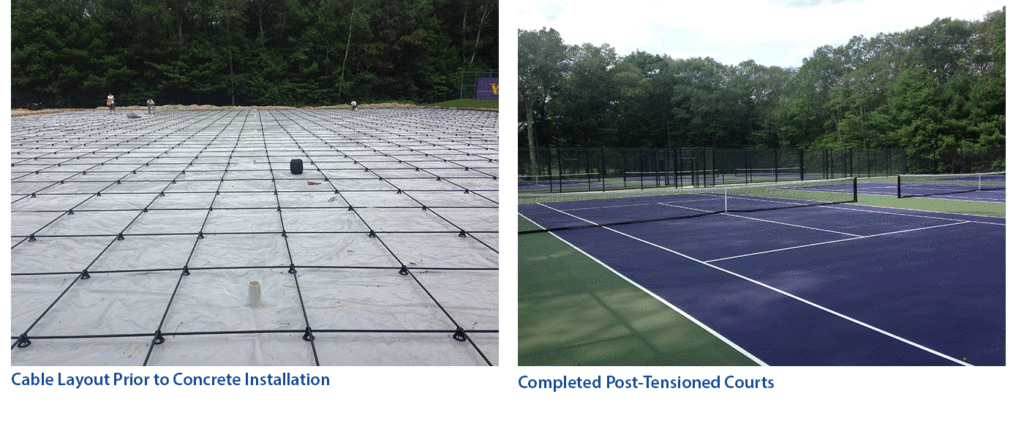Asphalt tennis courts may be the most commonly constructed hard-surfaced courts in the industry today. However, due to inconsistencies with the quality of asphalt in recent years, there is an increased interest in post-tensioned concrete courts. When considering the construction of a tennis facility, it is important to understand the basic differences between asphalt and post-tensioned concrete courts.
Asphalt Tennis Courts:
- Installation typically includes two courses of asphalt (wearing and binder) over a crushed stone base. The depth of the pavement system is based on recommendations resulting from a geotechnical investigation/report.
- Bituminous (asphalt) pavement is flexible and tends to be more affected by freeze/thaw cycles. Over time and under exposure to the elements, this often leads to surface and/or structural cracks.
- The design mix has an impact on the pavement’s lifespan. It may be beneficial to avoid incorporating recycled asphalt shingles and recycled asphalt pavement into the asphalt mix. The performance grade of the asphalt binder used in the design mix should be specifically tailored to the climate / environmental conditions of the proposed project’s geographic location.
- Asphalt paving may be more economical to install; however, there are higher maintenance costs throughout the life of the court due to repairing cracks and related re-application of the tennis surfacing system.

Post-Tensioned Concrete Tennis Courts:
- Post-tensioned (PT) concrete construction involves installation of a structural concrete slab over a prepared base. The concrete is reinforced with cables tensioned after the concrete is installed. The design of the pavement system is based on recommendations from a geotechnical investigation/report, as well as design recommendations from a registered structural engineer.
- PT construction is a rigid pavement system, and when properly installed, has a greater resistance to cracking. Cracks that may occur are typically hairline rather than the more significant cracks commonly seen in asphalt courts.
- During design, it is important to take into consideration a clear space around the perimeter of the courts to allow for the tensioning of the cables.
- PT construct is more expensive to install than asphalt; however, lower maintenance costs over the life of the court are typically experienced. Post-tensioned courts do not require the extent of crack repairing (and related tennis system resurfacing) typically associated with asphalt courts.
- PT systems have longer service life than asphalt courts.

Budgetary constraints are often a primary factor in selecting either asphalt or post-tensioned concrete. While asphalt systems have a lower initial cost, higher maintenance costs and an overall shorter lifespan is expected. Post-tensioned courts are significantly more expensive to install; however, they require less maintenance over the life of the court, and have a longer overall life expectancy.
Tagged In:
Athletic Facilities Planning & Design
